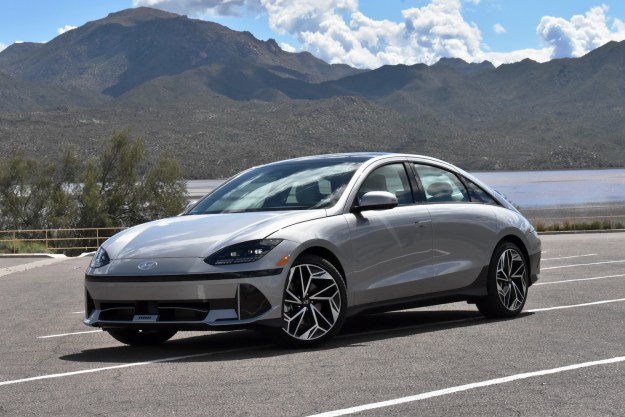When most carmakers unveil a new hybrid, they emphasize its fuel efficiency. But Hyundai decided to take a slightly different approach with its Ioniq Hybrid.
The Korean automaker sent a race-prepped version of its new Toyota Prius competitor to the Bonneville Salt Flats in Utah to set a land speed record. Sure enough, the little hatchback achieved an FIA-certified speed record for production-based hybrid vehicles, at 157.825 mph. Hyundai says the car even hit 160.7 mph briefly. The record-holding Ioniq Hybrid was displayed at the SEMA show in Las Vegas.
Built by a team from Hyundai Motor America’s engineering and quality group, the land speed record car got a few key modifications. It used the stock Ioniq Hybrid powertrain, which includes a 1.6-liter four-cylinder engine and six-speed dual-clutch transmission, with an electric motor sandwiched in between. Engineers added less-restrictive intake and exhaust systems, new software, and a nitrous-oxide system to boost power. Power-sapping air conditioning and accessories were also removed.
Read more: Toyota unveils 2,000-hp Land Speed Cruiser at SEMA
To improve aerodynamics, engineers used the front fascia from the Ioniq Electric model, which doesn’t have a drag-producing grille opening. They also made some tweaks to the underbody of the car, and added smooth wheel covers. Custom suspension lowered the ride height by 100 millimeters.
Like most racing vehicles, the interior was gutted to save weight and make room for safety equipment. In the Ioniq Hybrid land speed record car, that includes a roll cage, racing seat with six-point harness, a fire-suppression system, and battery disconnect. A parachute mounted to the rear hatch helps slow the car from 150-plus mph.
The Ioniq Hybrid is one of three Ioniq variants Hyundai will launch over the next three months. The carmaker says both it and the all-electric Ioniq Electric model will go on sale before the end of the year, and a plug-in hybrid version will follow next year. Hyundai is the first to offer these three types of powertrains in one model.
Editors' Recommendations
- Don’t let the gimmicks fool you. The Ioniq 5 N is a serious track car
- Hyundai Ioniq 9: price, release date, range, and more
- The Hyundai Ioniq 5 N makes one of the coolest EVs ready for the track
- Move aside, Tesla. The Hyundai Ioniq 6 is the best electric sedan for the masses
- I’m glad the Hyundai Ioniq 6 isn’t just a smaller Ioniq 5


